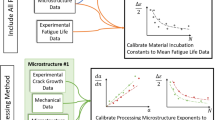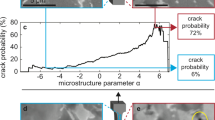Abstract
A novel predictive model for microstructurally small fatigue crack growth rates was developed using a three-part methodology. First, a deterministic model was created to predict microstructurally small fatigue crack growth behavior from long fatigue crack growth data using considerations of crack tip plasticity. Subsequently, microstructural barrier characteristic spacing/strength were modeled to introduce characteristic acceleration and deceleration mechanisms of grain- and secondary phase-controlled cracks. Finally, the deterministic model was coupled with a Monte Carlo technique, and used to make predictions of lifetime distributions and S–N curves with material and component specificity. Simple, metallographically measured parameters are used to make predictions, and the model provides insight into their respective roles in controlling fatigue crack growth lifetimes, and enables design practice optimization. The model predicts that, for cast Al-Si-Mg alloy A356, increasing matrix strength, grain size, and secondary dendrite arm spacing enhances overall fatigue crack growth resistance. Comparisons are made to experimental data, and show that successful predictions are made.











Similar content being viewed by others
Abbreviations
- A :
-
Power law pre-exponential constant
- A grain :
-
Grain cross-sectional area
- a :
-
Half crack length (internal crack) or crack length (surface crack)
- a t :
-
Transition crack length from MSC to PSC
- b :
-
Power law exponential constant
- C m :
-
Empirical constant relating colony size to the barrier sensitivity exponent
- c :
-
Crack length a plus the distance from the crack tip to the next barrier
- da/dN :
-
Crack growth rate
- (da/dN)MSC :
-
Microstructurally small crack growth rate
- (da/dN)PSC :
-
Physically small crack growth rate
- d n :
-
Proportionality constant between J and δ reflecting deviation from elastic behavior
- E :
-
Elastic modulus
- f 1 :
-
The fraction of dislocations on the slip band that participate in crack growth
- f v :
-
Volume fraction of secondary phase particles
- G :
-
Shear modulus
- GS :
-
Grain size (μm)
- i :
-
Index for the number of barriers traversed by the crack
- ΔJ :
-
Strain energy release rate of the crack; work per unit fracture surface area
- ΔJ elastic :
-
Elastic component of the strain energy release rate
- ΔJ MSC :
-
Microstructurally small crack strain energy release rate
- ΔJ plastic :
-
Plastic component of the strain energy release rate
- ΔJPSC :
-
Physically small crack strain energy release rate
- ΔJ total :
-
Total strain energy release rate; the sum of the elastic and plastic components
- K max :
-
Maximum stress intensity factor (per cycle)
- K norm :
-
Normalized stress intensity factor
- ΔK I :
-
Mode I stress intensity amplitude
- ΔK app :
-
Applied stress intensity amplitude
- ΔK eff-ACR :
-
Effective, ACR-corrected stress intensity amplitude
- ΔK MSC :
-
Microstructurally small crack stress intensity amplitude
- ΔK plastic :
-
Plasticity-induced stress intensity amplitude
- ΔK PSC :
-
Physically small crack stress intensity amplitude
- m :
-
Barrier sensitivity exponent
- N :
-
Number of secondary dendrite arms per dendritic cell
- N L :
-
Linear density of interdendritic particles
- N c.p./cell :
-
Number of colony particles per cell
- N c.p./junction :
-
Number of colony particles per junction
- N i.p./cell :
-
Number of interdendritic particles per cell
- N junction/cell :
-
Number of junctions per cell
- N total/cell :
-
Total number of particles per cell
- n :
-
Dimensionless ratio of crack length to crack length plus the distance from the crack tip to the next barrier (equal to a/c)
- n ACR :
-
Kmax sensitivity exponent
- \( n_{c}^{i} \) :
-
The critical value of n in the current zone at which slip initiates in the subsequent zone
- \( n_{s}^{i} \) :
-
The critical value of n in the subsequent zone at which slip initiates
- R :
-
Stress ratio
- r :
-
Average radius of secondary phase particle
- S :
-
Stress ahead of the plastic zone
- s :
-
Coordinate system defined along Γ
- T :
-
Traction vector along the outward normal of Γ
- u :
-
Displacement vector
- W :
-
Strain energy density
- x :
-
Cartesian coordinate axis with origin at the crack tip, parallel to crack surfaces
- y :
-
Cartesian coordinate axis with origin at the crack tip, perpendicular to crack surfaces
- α :
-
The ratio of microstructurally small to physically small crack growth rate, including the barrier magnitude effect
- Γ:
-
A contour surrounding the crack tip, evaluated counter-clockwise
- δ cl :
-
Crack mouth opening displacement at the minimum load
- δ i :
-
Initial crack mouth opening displacement prior to initiation from a starter notch
- δ nc :
-
Crack mouth opening displacement at the opening load
- Δδ elastic :
-
Elastic component of the crack tip opening displacement
- Δδ plastic :
-
Plastic component of the crack tip opening displacement
- Δδ total :
-
Total crack tip opening displacement; the sum of the elastic and plastic components
- ζ :
-
Dimensionless coordinate system = x/c
- \( \zeta_{0}^{i} \) :
-
The value of ζ at which slip initiates in zone i
- κ :
-
Constant = 1 for screw dislocations and = 1 − ν for edge dislocations
- ν :
-
Poisson’s ratio
- Δσ app :
-
Far-field applied stress amplitude
- σ ys :
-
Matrix yield strength
- τ :
-
Resolved shear stress on the plane of crack growth
- φ :
-
Plastic displacement along the slip band
- φ MSC :
-
Plastic displacement along the slip band attributed to the microstructurally small crack
- φ PSC :
-
Plastic displacement along the slip band attributed to the physically small crack
References
D.A. Lados, D. Apelian, and J.K. Donald: Acta Mater, 2006, vol. 54, pp. 1475–86.
J.M. Boileau: Ph.D. dissertation, Wayne State University, 2000.
D.A. Lados, D. Apelian, and J.F. Major: Metall Mater Trans A, 2006 vol. 37, pp. 2405–18.
S. Suresh, G.F. Zamiski, and R.O. Ritchie: Metall Mater Trans A, 1981, vol.12, pp. 1435-1443.
D.A. Lados, D. Apelian, P. Paris, and J.K. Donald: Int J Fatigue, 2005, vol. 27, pp. 1463-72.
J.C. Newman and W. Elber: ASTM STP 982, Mechanics of fatigue crack closure, Philadelphia, PA, ASTM, 1988.
E. Zaiken and R.O. Ritchie: Metall Trans A – Phys Metall Mater Sci, 1985, vol. 16, pp. 1467-77.
B.A. Bilby, A.H. Cottrell, and K.H. Swinden: Proc R Soc Lond A, 1963, vol. 272, pp. 304-14.
J. Weertman: Int J Fract Mech, 1966, vol. 2, pp. 460-7.
A. Shyam, J.E. Allison, and J.W. Jones: Acta Mater, 2005, vol. 53, pp. 1499-1509.
A. Navarro, E.R. Rios (1992) Proc. R. Soc. Lond. A. 437:375-90.
W. Schaef and M. Marx: Acta Mater, 2012, vol. 60, pp. 2425-36.
T. Zhai, A.J. Wilkinson, and J.W. Martin: Acta Mater, 2000, vol. 48, pp. 4917-27.
A.G. Gavras: Ph.D. Dissertation, Worcester Polytechnic Institute, 2012.
A.G. Spangenberger, D.A. Lados, M. Coleman, S. Birosca, and M. Hardy: Int J Fatigue, 2016, vol. 97, pp. 202-13.
ASTM Standard E647, 2013e1, ASTM International, West Conshohocken, PA, 2003.
J.K. Donald: Mechanics of Fatigue Crack Closure, Philadelphia, PA, ASTM, 1988, pp. 222-9.
J.R. Rice: J Appl Mech, 1968, vol. 35, pp. 379-86.
M. Yoda: Int J Fracture, 1980, vol. 16, pp. 175-8.
T.L. Anderson (2000) Fracture mechanics fundamentals and applications, second edition. CRC Press LLC, Boca Raton, pp. 117-22.
J.W. Hutchinson: J Mech Phys Solids, 1968, vol. 16, pp. 13-31.
H. Li and F. Ebrahimi: Mater Sci Eng A, 2003, vol. 347, pp. 93-101.
L. Lu, R. Schwaiger, Z.W. Shan, M. Dao, K. Lu, and S. Suresh: Acta Mater, 2005, vol. 53, pp. 2169-79.
M.F. Ashby and D.R.H. Jones: Engineering materials: an introduction to their properties and applications, Pergamon, Oxford, 1980, pp. 71-81.
S. Taira, K. Tanaka, and Y. Nakai: Mech Res Comm, 1978, vol. 5, pp. 375-81.
A. Navarro and E.R. Rios: Fatigue Fract Engng Mater Struct, 1987, vol. 10, pp. 169-86.
E.R. Rios, X.J. Xin, and A. Navarro: R Soc Lond A, 1994, vol. 447, pp. 111-34.
S. Ghosh, Z. Nowak, and K. Lee: Acta Metall, 1996, vol. 45, pp. 2215-34.
C. Corti: Int Metall Rev, 1974, vol. 19, pp. 77-88.
F. Schäfer, L. Weiter, M. Marx, and C. Motz: Philos Mag, 2016, vol. 96, pp. 32-34.
D. Wilson, Z. Zheng, and F.P.E. Dunne: J Mech Phys Solids, 2018, vol. 121, pp. 147-174.
W. Wen and T. Zhai: Metall Trans A, 2012, vol. 43A, pp. 2012-2743.
G. Marsaglia and W.W. Tsang: J Stat Soft, 2000, vol. 5, pp. 1-7.
W.A. Bailey: Foundry, 1965, vol. 95, pp. 96–101
J.F. Major: Trans Am Foundry Soc, 1998, vol. 102, pp. 901-906.
Acknowledgments
This work was supported by the National Science Foundation (Grant Number 1151588) and the members of the Integrative Materials Design Center (iMdc) at Worcester Polytechnic Institute.
Author information
Authors and Affiliations
Corresponding author
Additional information
Publisher's Note
Springer Nature remains neutral with regard to jurisdictional claims in published maps and institutional affiliations.
Manuscript submitted March 5, 2019.
Rights and permissions
About this article
Cite this article
Spangenberger, A.G., Lados, D.A. A Novel Physics-Based Predictive Model for Small Fatigue Crack Growth with Microstructural Sensitivity in Cast Aluminum Alloys. Metall Mater Trans A 50, 4364–4377 (2019). https://doi.org/10.1007/s11661-019-05349-z
Received:
Published:
Issue Date:
DOI: https://doi.org/10.1007/s11661-019-05349-z




